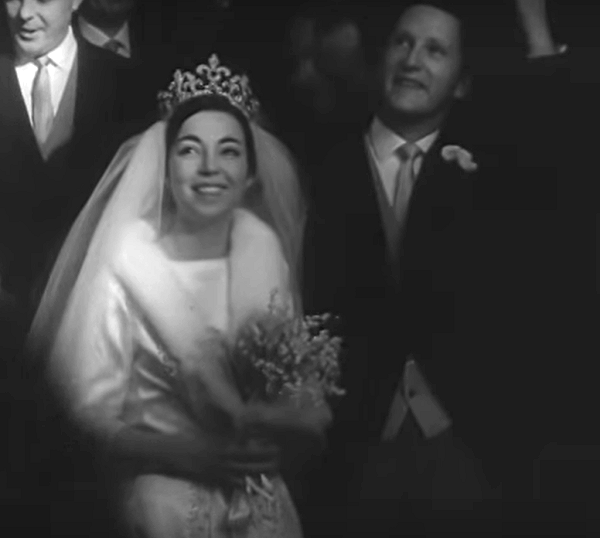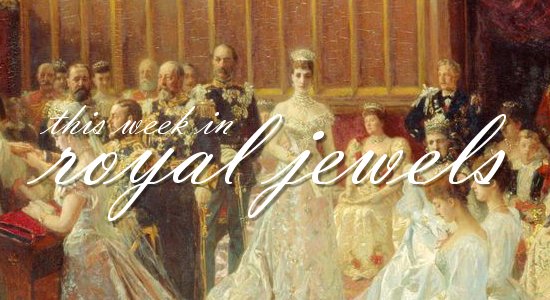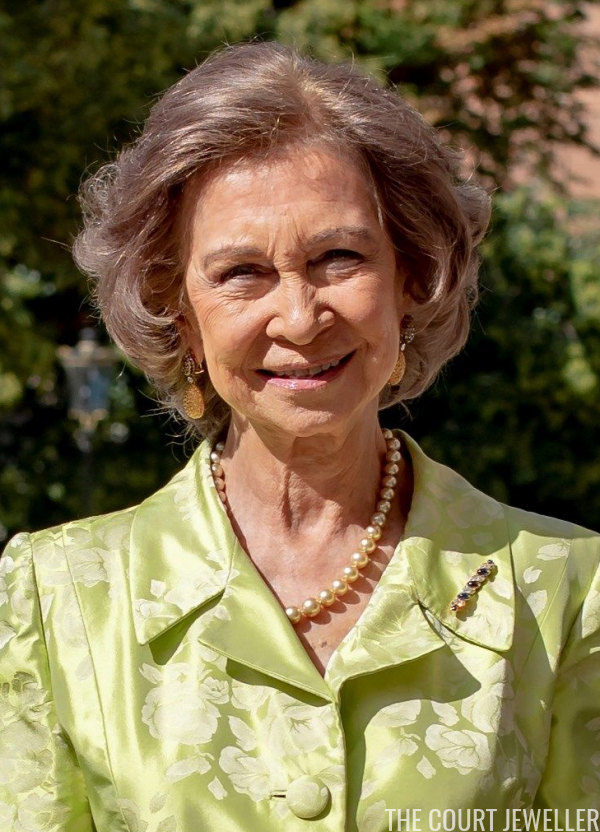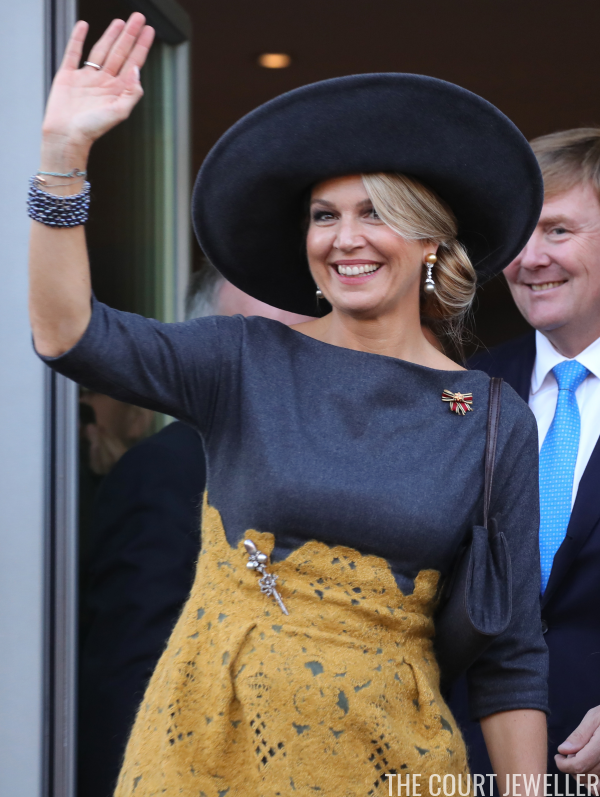 |
| Princess Marie Louise of Bulgaria wears the Bulgarian Fleur-de-Lis Tiara (Wikimedia Commons) |
Royal families often own tiaras that are full of symbols related to their countries and dynasties. Today’s sparkler, the fascinating Bulgarian Fleur-de-Lis Tiara, is a particularly interesting example.
 |
| Prince Ferdinand and Princess Marie Louise photographed in Austria, ca. 1893 (Wikimedia Commons) |
In 1887, Bulgaria’s National Assembly was searching for a new sovereign. The previous ruling prince, Alexander of Battenberg (brother of Prince Henry and Prince Louis, who both married into the extended British royal family), had abdicated a year earlier following a military coup. The assembly found its new prince in Ferdinand of Saxe-Coburg and Gotha. He was a well-connected royal, with family ties to the British, Portuguese, and Belgian royal families. He was also a grandson of King Louis Philippe I, who had reigned in France from 1830 to 1848.
Ferdinand was formally elected as the next Prince of Bulgaria in July 1887. His ascension was greeted with shock by many of his fellow European sovereigns; Queen Victoria wrote that he was “unfit” for the role and “should be stopped at once.” Regardless, he had a much longer tenure as sovereign than his predecessor. Soon, he was on the hunt for a royal bride to help him secure the line of succession. This wasn’t an easy task. One British newspaper reported that it was “well known” that Ferdinand had “proposed to half the eligible princesses of Europe,” and had “failed in all his numerous matrimonial ventures in England, Bavaria, Austria, and Belgium.”
Ferdinand’s mother, Princess Clementine, worked for years on negotiations with Robert, Duke of Parma, hoping to arrange a marriage for Ferdinand with Robert’s eldest daughter, Princess Marie Louise of Bourbon-Parma. (Robert had a total of twenty-four children; Marie Louise’s siblings included Empress Zita of Austria-Hungary and Prince Felix of Luxembourg.) After several years, Clementine finally succeeded, and the engagement between Marie Louise and Ferdinand was officially announced in February 1893.
 |
| Princess Marie Louise, ca. 1893 (Wikimedia Commons) |
Prince Ferdinand and Princess Marie Louise met for the first time during their engagement celebrations at the bride’s family home, Schwarzau Castle, in Austria. (Marie Louise’s stepmother, Infanta Maria Antonia of Portugal, was the sister of Archduchess Maria Theresa of Austria. She was the sister-in-law of Emperor Franz Josef I.) They married in a Catholic ceremony in the chapel of the Duke of Parma’s Italian villa in April 1893.
The Bulgarian people celebrated the arrival of their new princess with a special national gift: a tiara featuring the country’s national colors, presented on behalf of the women of the nation. The diamond, emerald, and ruby tiara, with its distinctive fleur-de-lis designs, was made by Köchert, the Viennese firm that became famous as court jeweler of the Austrian imperial court. (The fleur-de-lis tiara is sometimes confused with the small crown, or coronet, that was given to Marie Louise by her groom; that crown, also made by Köchert, features fleur-de-lis elements in its design and was set with diamonds, emeralds, rubies, and sapphires.)
 |
| Princess Marie Louise, ca. 1893 (Wikimedia Commons) |
Contemporary newspaper reports described the fleur-de-lis tiara as “a superb diadem” that would undoubtedly become “the most conspicuous ornament among the Bulgarian crown jewels.” One paper noted that the tiara was made of “five magnificent clusters of diamonds in the shape of the Bourbon lily. The base of the diadem is made of rubies, emeralds and diamonds, representing the Bulgarian colors — red, white, and green. On the central lily is a ruby of rare brilliancy and value.” Marie Louise often wore the fleur-de-lis tiara with other ruby and diamond jewels from her collection. In this impressive bejeweled portrait, the princess wears the tiara with her ruby and diamond festoon necklace, as well as a ruby and diamond negligee-style pendant brooch.
 |
| Philip de Laszlo’s portrait of Princess Marie Louise, ca. 1894 (Wikimedia Commons) |
In de Laszlo’s famous portrait of Princess Marie Louise, he depicts her wearing the tiara with the ruby negligee brooch pinned at her neck, plus a diamond and emerald cluster brooch on the bodice of her gown. Her wrists are adorned with more diamond and emerald bracelets.
Although the marriage between Ferdinand and Marie Louise was not a love match, the couple had four children together. Their eldest son, Prince Boris, was born nine months after their wedding. In 1899, twenty-nine-year-old Marie Louise died after giving birth to their fourth child, Princess Nadezhda.
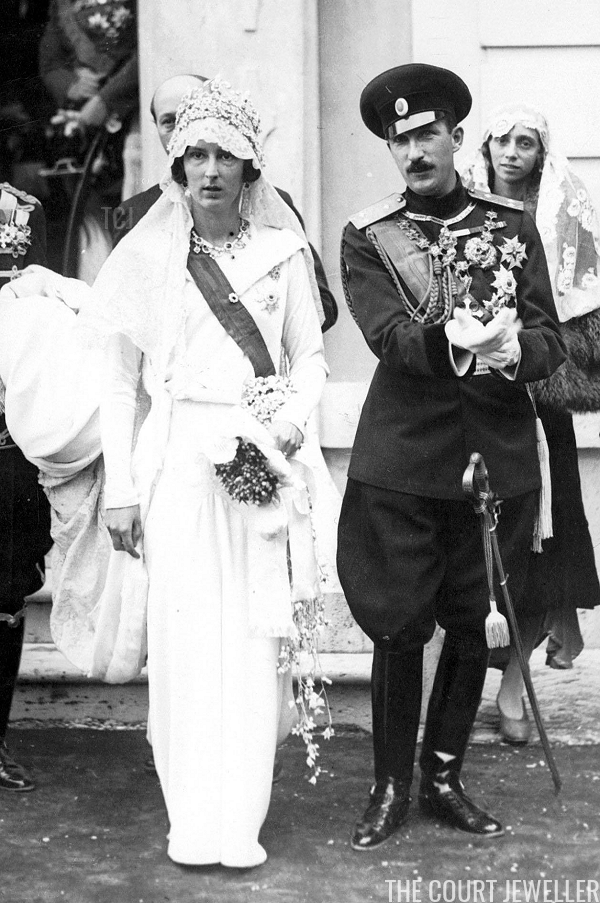 |
| Boris and Giovanna pictured in Assisi at their wedding luncheon, October 1930 (Scherl/Süddeutsche Zeitung Photo/Alamy) |
Three decades passed before the tiara was worn in public again. Ferdinand — who was upgraded to the title of tsar in 1908 — passed the throne to his elder son, Boris III, at the end of World War I. In 1930, Boris married Princess Giovanna of Italy, the fourth child of King Vittorio Emanuele I and Queen Elena. Boris had been baptized Catholic but converted as a small child to the Eastern Orthodox faith. His marriage to an Italian Catholic princess was a complicated matter. It took several months of diplomatic negotiations between the families, the governments, and both churches before the engagement could officially be announced by the bride’s parents in October 1930. The couple were pelted with rain and hail when they arrived for their Catholic wedding ceremony at the Basilica of St Francis of Assisi on October 25.
 |
| Giovanna wearing the tiara at her wedding luncheon in Assisi, October 1930 (Scherl/Süddeutsche Zeitung Photo/Alamy) |
Giovanna did not wear a tiara for the Italian wedding ceremony, choosing instead to anchor her lace veil with a garland of flowers. Afterward, however, she added the Köchert fleur-de-lis tiara to her ensemble for the wedding luncheon that followed at Villa Constanzi in Assisi. The photo above shows the tiara on the new queen (or tsaritsa) at the lunch celebrations; you’ll note that she’s also wearing Princess Marie Louise’s ruby and diamond festoon necklace. She wore the tiara again a few days later, when the couple was married again in an orthodox ceremony at the Alexander Nevsky Church in Sofia. Giovanna subsequently took on the Bulgarian version of her name, becoming known as “Tsaritsa Ioanna.”
Boris and Ioanna had two children, Princess Marie Louise and Prince Simeon, both born before the outbreak of World War II. (Bulgaria and its royal family occupied complicated political territory during the war. In 1943, after a meeting with officials in Berlin, Boris suddenly (and mysteriously) died. He was succeeded by six-year-old Simeon, whose uncle, Prince Kyril, served as regent.
 |
| Simeon and Margarita on their wedding day in Switzerland, January 1962 (screencapture) |
Simeon II of Bulgaria is one of the most interesting royal figures of the past century. After becoming a monarch as a young child, Simeon’s life went through another upheaval when he was seven. The Soviets invaded Bulgaria, executing Prince Kyril and sending Simeon, his mother, and his sister into house arrest. In 1946, the Bulgarian monarchy was officially abolished by a referendum, and the family went into exile. They fled to Egypt, where Ioanna’s father, the deposed Italian King Vittorio Emanuele, was living. He was educated there until the family was granted asylum by General Franco and allowed to move to Spain. Throughout their life in exile, however, the family managed to hold on to a good deal of their jewelry.
In Spain, Simeon met his future wife: Margarita Gómez-Acebo y Cejuela, daughter of the Marquess of Cortina. Unfortunately, she was especially equipped to understand Simeon’s traumatic childhood, as her parents had been executed during the Spanish civil war. Like Simeon, she had been displaced during the war, living with various relatives in France and Spain. The couple celebrated their marriage with a pair of ceremonies — a civil wedding and an orthodox ceremony — in Lausanne in January 1962. For the religious ceremony, pictured above, Margarita wore the Köchert fleur-de-lis tiara with a tulle veil. The tiara was also worn by Simeon’s sister, Princess Marie Louise, for her wedding to Prince Karl of Leiningen in 1957.
 |
| Simeon, pictured in France during his tenure as Bulgaria’s prime minister, November 2006 (STEPHANE DE SAKUTIN/AFP via Getty Images) |
Simeon and Margarita raised a large family in Spain, and all five of their children — Kardam (who died in 2015), Kyril, Kubrat, Konstantin-Assen, and Kalina — married Spaniards. The family maintains close ties with the Spanish royal family. At the end of the Communist era, Simeon returned to Bulgaria, where his public life took yet another fascinating term. In 2001, he was elected as Prime Minister of Bulgaria, serving in the role for the next eight years.
 |
| Simeon and Margarita at Buckingham Palace, May 2012 (Chris Jackson/Getty Images) |
Though Simeon and Margarita have found a home again in Bulgaria, we haven’t seen the tiara in more than half a century. There’s been loads of speculation about where it is — whether the family still owns it, or if it’s been broken up, or even sold. The word on the street is that the family does still own the tiara, but that it is extremely fragile and unable to be worn. If that’s true, I’d love to see this one restored and brought out for us to see and enjoy once more!
